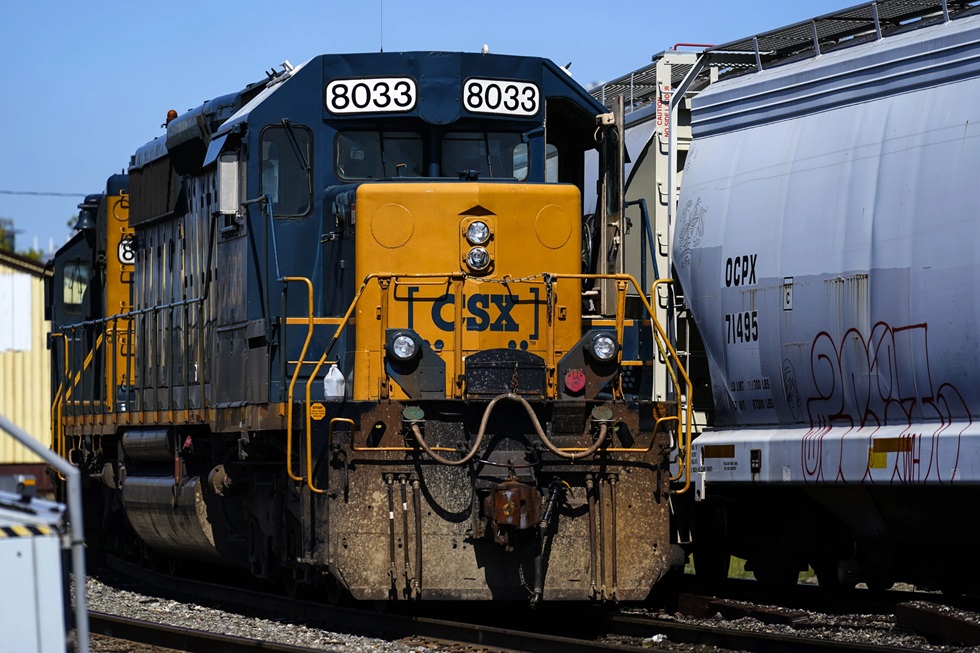
WASHINGTON—The nation’s rail unions and the AFL-CIO’s Transportation Trades Department are hailing the Biden administration’s final rule mandating two-person crews on all but a few of the nation’s freight trains.
About the only union-side objections to the Federal Railroad Administration’s rule, published April 2, were that it shouldn’t override even tougher state laws, which apply the two-person crew mandate to all freight trains, even on small short lines.
The rule, strenuously opposed by the nation’s freight railroads, orders a minimum two-person crew—the engineer and the conductor—on all freight trains, especially those miles-long trains the nation’s big Class I railroads run.
The unions have lobbied for two-person crews, both at the Transportation Department, the parent agency of the FRA, and on Capitol Hill, for years, but the rail lobby has always blocked congressional action. And it convinced the GOP Trump regime’s FRA to allow one-person crews, as a money-saver.
The unions reply that two-person crews are a safety measure and that the presence of a second worker can either prevent accidents or when they occur, reduce the hazards to railroaders, communities, and the environment.
“This rule acknowledges crew size is fundamentally a safety issue at its core,” said Transportation Trades Department President Greg Regan. “Rail workers experience the risks of the job daily, and made it clear two-person crews are inherently necessary to ensure the safe operation of our rail systems.
“While the FRA has considered action on crew size for almost a decade, operational and safety changes across the rail industry the last several years have only heightened the need for strong crew size regulations.” That’s why the Biden rule is so needed, Regan said.
“For the past 13 years our union, the Brotherhood of Locomotive Engineers and Trainmen advocated for a federal rule requiring trains be staffed by a minimum of one certified engineer and a certified conductor,” said Eddie Hall, the new president of the BLET/Teamsters. “We also repeatedly tried to reason across the bargaining table for railroads to adopt these minimum staffing requirements.”
Hall called the federal rule “an important step in making railroading safer in every state, rather than taking a piecemeal approach.
“As trains, many carrying hazardous material, have grown longer, crews should not be getting smaller. I personally have operated freight trains that stretched over three miles in length,” as an engineer on the Southern Pacific and Union Pacific.
Some states moved early
Hall explained 11 states, “concerned about the public’s safety” passed their own two-person crew mandates. Those states include Illinois, the key rail crossing in the national network, Washington state, Nevada, the gateway to the big California market, and New York, where workers handle all freight not only from the Empire State but from New England.
A rail re-regulation bill, authored by Sen. Sherrod Brown, D-Ohio, with bipartisan support, includes two-person crews as a safety measure. Freight railroads’ lobbying has sidetracked it.
“Common sense tells us that large freight trains, some of which can be over three miles long, should have at least two crew members on board–and now there’s a federal regulation in place to ensure trains are safely staffed,” Transportation Secretary Pete Buttigieg said in a statement announcing the rule. “This rule requiring safe train crew sizes is long overdue, and we are proud to deliver this change that will make workers, passengers, and communities safer.”
FRA said, “important safety functions that could be lost when reducing crew size to a single person.” They include eliminating rigorous risk assessments, not lessening or fixing known risks—such as freight car axle cracks that overheated, snapped the axles, and derailed the Norfolk Southern freight train in East Palestine, Ohio, “and even notifying FRA.
“The final rule closes this loophole by establishing minimum standards and federal oversight to empower communities and railroad workers to make their voices heard by allowing for public input during FRA’s decision-making” on granting railroads’ waiver demands to permit one-person crews.
“Illinois is one of the nation’s most important rail hubs, and two-person crews on our railways help ensure our workers can safely move vital goods across America,” said Pat Devaney, Illinois AFL-CIO Secretary-Treasurer. The state had its own two-person crew law, but a court threw it out. “We are thankful to the Biden administration for continuing to put workers first and ensuring rail workers across the country have the same protections we passed in Illinois.”
“Smart-TD and rail workers across Illinois and the country have long advocated for common-sense crew size regulations to ensure freight trains are operated with a minimum of two crew members,” said Illinois State Director Bob Guy. The federal rule “supports the work we’ve already done here in Illinois. By creating parity across the country, we are protecting the safety of rail workers, local communities, and the environment.”
“This rule acknowledges the value the Brotherhood of Locomotive Engineers and Trainmen places on safety and maintains partnerships that keep our members and the public safe,” said Illinois BLET Legislative Board Chairman Cory Martin. “America’s railroaders are committed to the safest possible transportation of passengers and freight, and a two-person crew is crucial to that goal.”
He said the federal rule is “putting people before profits.”
Other rail union commenters, including Regan of the Transportation Trades Department, praised the FRA two-person crew rule but said it should not override even stronger state regulations. Smart-TD’s Washington State Legislative Board took that stand, noting some state rail crew laws are “equal to or more stringent” than the federal rule Buttigieg announced.
As might be expected, the rail lobby, the Association of American Railroads, opposed the new rule. It argues data shows no safety difference between one-person and two-person crews. For almost a decade, AAR freight railroads have implemented the Precision Scheduled Railroading system, which has cut the number of rail workers by a third and lessened safety checks and oversight, all to create higher profits. It calls the rule “unfounded…unnecessary,” with “no proven connection to rail safety.
AAR, hypocritically, said the federal rule pre-empts collective bargaining, conveniently not mentioning its members always reject two-person crews. Indeed, execs with one big freight, the Burlington Northern Santa Fe, advocate crewless trains in some circumstances. The lobby’s press office did not respond to an e-mail asking if it would sue in federal court to overturn the two-person crew rule, as other corporate classes have done against other Biden administration rules.
We hope you appreciated this article. At People’s World, we believe news and information should be free and accessible to all, but we need your help. Our journalism is free of corporate influence and paywalls because we are totally reader-supported. Only you, our readers and supporters, make this possible. If you enjoy reading People’s World and the stories we bring you, please support our work by donating or becoming a monthly sustainer today. Thank you!










